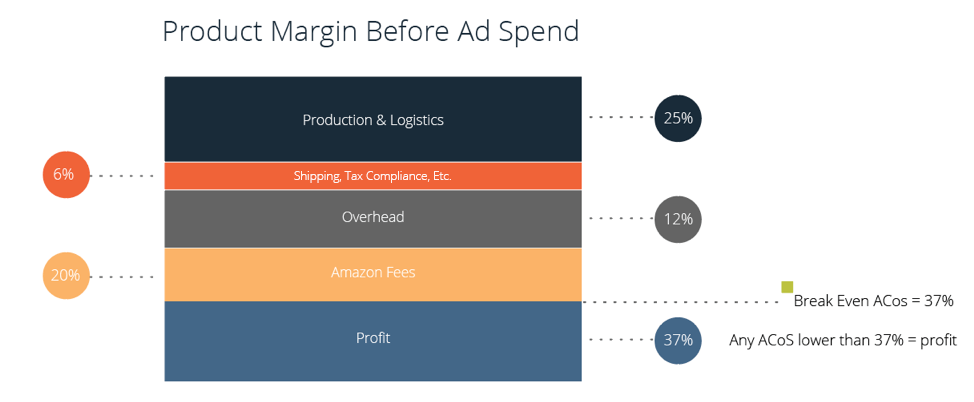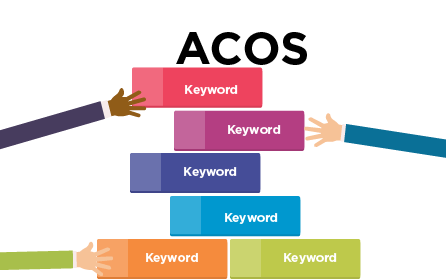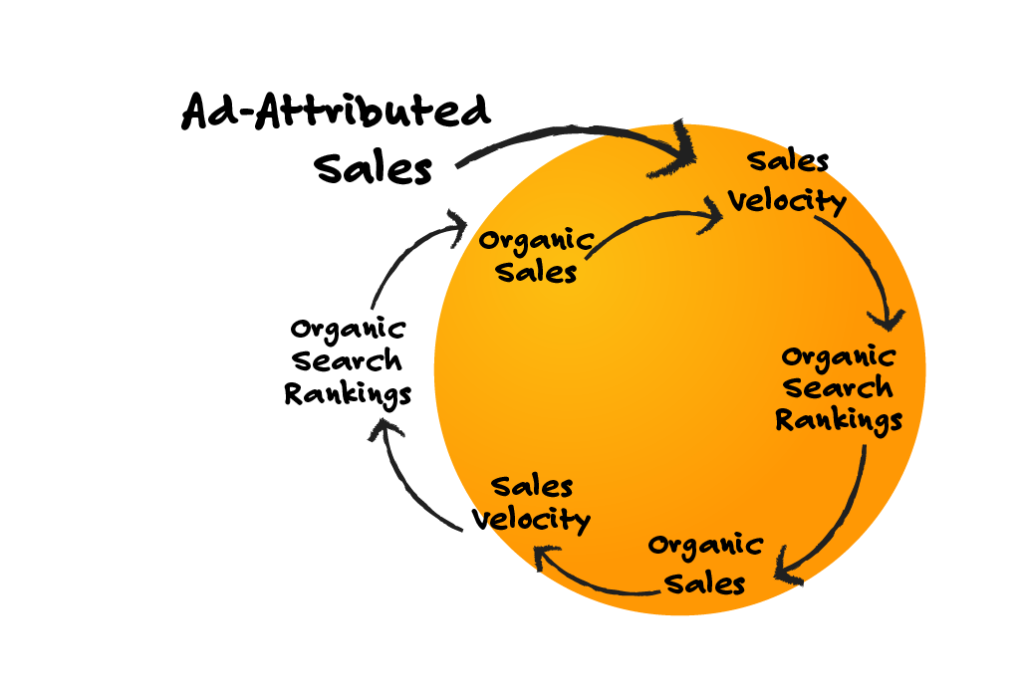
Ever used Amazon Sponsored Products Ads or Sponsored Brand Ads to increase your sales on Amazon? Then you’re probably familiar with the term ACoS, which stands for advertising cost of sale. You may have even heard that a successful ad campaign is one with the lowest possible ACoS. But is that true? In this post, we’ll explain why that’s shortsighted. We’ll also show you why focusing on trying to improve ACoS at all costs might be hurting your Amazon business.
By Dave Karlsven and Joseph Hansen
Table of Contents
- What Is ACoS?
- Don’t Try to Improve ACoS in a Vacuum
- Why ACoS Falls Short
- So, Should You Ignore ACoS?
- How Keywords Can Mislead When it Comes to Optimizing ACoS
- How Savvy Competitors Can Use Your ACoS Targets Against You
- Don’t Play Checkers with Your Ads—Play Chess
- What ACoS Doesn’t Show—and Why Waiting Can Be Smart!
- Don’t Let ACoS Compromise Your Sales Velocity
- If Not ACoS, Then What?
What Is ACoS?
Advertising cost of sale (ACoS) is one of the key metrics used to indicate the performance of Amazon Sponsored Products ad campaigns. ACoS measures the average cost of an ad on Amazon to generate a sale.

The basic formula to calculate ACoS is ad spend divided by sales.
For example: If you spend $100 on ads and generate $400 in sales, then the ACoS = 100 / 400 = 25%. This means 25 cents spent on ads make $1 in sales for you with that ad campaign.
In contrast, if you spend $100 on ads and generate $50 in sales, then the ACoS = 100 / 50 = 200%. This means you’d spend $2 on ads to generate only $1 in sales.
Don’t Try to Improve ACoS in a Vacuum
A quick search in Seller Central or on Google produces volumes of information including articles, courses, training videos, and software around the importance of lowering ACoS.
We acknowledge there is some benefit to some of these solutions that target ACoS. And we certainly don’t suggest brands and sellers entirely ignore Amazon’s manufactured metric of ACoS. But our experience in developing ad strategies for clients has taught us about some commonly missed opportunities that result from making advertising decisions based solely on ACoS.
Chasing a lower ACoS without considering other vital metrics can actually end up hurting your sales and profits on Amazon.
Focusing only on ACoS, marketers and advertising managers often let this metric guide their decision-making. Unfortunately, managing your ad budget to a specific ACoS will not necessarily produce the most profit.
In this article, you’ll learn why you shouldn’t fall for the trap of trying to improve ACoS at the expense of everything else.
In a follow-up article, you’ll learn how to look at ACoS in combination with several other metrics that matter to make smart decisions about ad spend and drive greater profits and sales. You’ll also learn about the proprietary framework for Amazon ad campaigns we use to reliably generate profits for our clients every day.
With that out of the way, let’s talk about precisely why you shouldn’t be focused on trying to improve ACoS in a vacuum.
Why ACoS Falls Short
Many ad managers and Amazon ad software solutions use ACoS as the central metric they consider when evaluating the profitability of their ads.

For example, take the cost structure of this hypothetical product:
The net profit margin is 37%. Viewed simply, if you spend less than 37% on advertising, you remain profitable. Spend more than 37%, and your products are in the red.
But that’s often a mistake.
There’s a lot missing from this model, and it ties your decision-making solely to your ACoS on the false assumption that ad spend always eats directly into profits. As a result, you only bid and spend at levels below this breakeven point so that you remain “profitable.”
In truth, ACoS is a misleading indicator on its own, because it is based only on the last-touch attribution of an ad click to an Amazon listing. (In a last-touch attribution model, 100% of the conversion credit goes to the last action the customer performed.)

Unfortunately, a focus on ACoS and, by extension, last-touch attribution creates bias against upper-funnel ads. When you only track the last click or view, you don’t know how the customer found your products or how many times they interacted with your brand before converting. This often leads budget away from keywords and ad types that help drive customers to discover and engage with your brand.
A recent Stanford study discovered that people who saw a display ad campaign made 5-25% more campaign-related searches than people who didn't see the campaign. Last-touch attribution models may keep you from correctly assessing the value of channel and campaign overlap.
So, a program built on ACoS ignores the positive benefits of mid- and upper-funnel advertising because Amazon’s system simply doesn’t allow you to adequately measure the true attribution of those ads.
So, Should You Ignore ACoS?
ACoS is by no means useless, but it can be a misleading metric because it doesn’t tell the entire story.
But that doesn’t mean you should ignore it. Instead, you should weigh ACoS holistically among other important metrics, which we’ll talk about in the next article.
But first, to use ACoS wisely, you need to understand its limitations and how it can be manipulated.
How Keywords Can Mislead When it Comes to Optimizing ACoS
ACoS can be manipulated to tell a variety of narratives when managed at the campaign level.

The fundamental problem is that one ad campaign may contain multiple keywords and different products with different profit margins. This can make looking at ACoS at the campaign level confusing and even misleading. A campaign’s keyword mix can raise or lower that campaign’s ACoS—even when the overall performance of the ads in driving sales and profits has not changed.
Put another way, you can easily manipulate a campaign’s ACoS up or down by moving different keywords with a higher or lower ACoS in or out of the campaign.
You see, good (i.e. low-ACoS) non-brand keywords at the top of the funnel will always come at a higher ACoS than brand keywords at the bottom of the funnel.
So when you move a good, low-ACoS keyword into a campaign with a high ACoS, what happens? The campaign’s overall ACoS comes down without actually improving the performance of your ad spend on any of your keywords. The new grouping looks better on paper, but your return on ad investment has not improved.
Pull that low-ACoS keyword back out of the campaign and put it somewhere else, and what happens? The campaign ACOS shoots right back up again. Unfortunately, the ACoS of any given campaign, unless structured with keyword isolation, does not give you valuable information to manage your bids effectively. Your analysis and action should occur on an exact-match keyword level.
If that weren’t difficult enough, the way many sellers focus on trying to improve ACoS opens the door for competitors to steal market share.
How Savvy Competitors Can Use Your ACoS Targets Against You
The next big issue with ACoS is that it can be exploited by competitors looking to siphon market share.
Let’s say a direct competitor starts running a promotion that undercuts one of your products on price. They also get more aggressive on their bidding on some of the same “good,” low-ACoS, keywords you’re bidding on…
That competitor, at the promo-price, will have a more attractive offer with a higher click-through rate from customers. As a result, they will receive greater relevance from Amazon’s ad algorithm. You’ll either need to increase your bids on those good keywords to compete, or risk losing impression share and sales volume on those lower-ACoS keywords.
You can “inflate” or “deflate” the ACoS of your ad campaigns—but is it the metric you should be focused on?
In addition, your conversion rate will go down as the competitor takes more of your sales.
All of this will lead to an increase in ACoS for your campaign, no matter what you do. If you bid higher, your ACoS on those “good” keywords will go up in order to keep you competitive. But if you don’t bid higher (in order to stay at a certain ACoS threshold for those keywords), you’ll lose impression and sales from those “good” keywords. Result? Your total sales drop while your overall ACoS increases because more of your sales are coming from fewer of those “good” keywords.
Don’t Play Checkers with Your Ads—Play Chess
Often sellers will programmatically abandon their best keywords due to rising ACoS. They set pre-determined “bailout” levels out of fear of spending too much for a short-term, last-touch attribution sale. Unfortunately, this strategy is a checker’s maneuver in a game of chess. Don’t set limitations in your bidding strategies or use software that is easily manipulated into making short-sighted decisions. You’ll quickly give up market share to your competitors.
If you’re managing your ads to a target ACoS percentage using an automated software tool, your software may pause those previously good keywords. Now that you’re no longer bidding on those keywords, you’ll start losing market share to your competitor.
You paused these keywords because you didn’t want to “waste money” on them because of their high ACoS. But let’s say it does make sense to pause keywords that have escalating ACoS. Do you have anything set up in your automated bidding system to tell you when to turn those good keywords back on?
You don’t? Well, surprise! You may have just lost out to a competitor who outsmarted you and is now enjoying all the sales and impressions at the favorable CPCs you once had.
We’ve used this strategy of driving up ACoS on the best keywords for our clients to squeeze out competitors who are pausing ads on those keywords. Many of these competitors don’t have rules in place that tell them when to turn those keywords back on. So, we get to take over the best keywords and enjoy an even lower ACoS than before.
What ACoS Doesn’t Show—and Why Waiting Can Be Smart!
In the beginning stages of an Amazon ad campaign, our clients often ask us to stop running seemingly low-performing, high-ACoS ads. Why? They assume these ads aren’t worth the spend.
Please don’t make this assumption. You want your ads running long enough to determine which ones will help drive organic sales pushed by Amazon’s algorithm.
Making a snap decision to avoid a high ACoS can make a bad situation worse by reducing your momentum in Amazon’s algorithm.
Here’s two examples to illustrate the point. Let’s say you’re selling Asics running shoes on Amazon. Consider the following scenarios:
Scenario 1: A high-ACoS non-brand keyword (“blue running shoes”) is driving a lot of brand search (“Asics running shoes”) sales.
In this case, the ACoS of that non-brand keyword can’t tell us anything about the positive indirect impact of the keyword. If you turn that keyword off, then you risk hurting those sales and profits.
Scenario 2: A high ACoS non-brand keyword (“blue running shoes”) is driving sales velocity and organic rankings for a competitive keyword (“running shoes”), which in turn drives organic sales of your Asics running shoes.
In this case, ACoS doesn’t give us any insight into this secondary impact of the keyword. Again, if we turn that keyword off, sales and profits suffer.
Managing ads exclusively to ACoS can lead to missed opportunities and make it difficult to scale your ad spend. Simply put, using ACoS as the centerpiece for analysis, planning, and management will limit your growth and overall profitability.
Don’t Let ACoS Compromise Your Sales Velocity
Your Amazon sales velocity is the number of sales you get in a certain amount of time.

Ad-driven sales give your sales velocity a kick-start. And when done correctly (targeting keywords with a high conversion rate), they can help your organic rankings. Here’s a rough idea of what that looks like:
Some customers on Amazon will search for your brand’s products directly (“Twinings peppermint tea”), while others search more generally (“peppermint tea”).
But what if a lot of shoppers are purchasing Twinings peppermint tea? The increased sales velocity for that product means Amazon will start showing these product listings more prominently to shoppers looking for “peppermint tea.”
Thus, high-ACoS ads running more general non-brand keywords like “peppermint tea” can often help drive organic brand sales.
But this is something that can’t be captured by only trying to improve ACoS!
Your ad-attributed sales increase your sales velocity, organic search rankings, and organic sales. This naturally brings down your total return on ad spend (ROAS), but doesn’t affect your ACoS. So while you’re spending less as a percentage of total sales (i.e., you’re more profitable), your ACoS remains the same.
If Not ACoS, Then What?
So what should you be looking at instead of trying to improve ACoS in isolation? How do you decide what keywords to bid higher or lower on, and which ones to scrap? How can you reliably make decisions for your campaigns that result in profits?
By paying attention to the metrics that matter most—which we’ll discuss in an upcoming post.

If you’re one of the estimated 20%–40% of brands who fire their agency annually, you can’t focus on that vision if you have to keep searching for the right support. BBE proudly retained >95% of our clients last year while applying focused dedication to our brand partners. If you’re ready to start over for the last time, contact us and find out why leading brands have partnered with us for so long.

